With Flexible Grouping We Can Reach Every Kid
A classroom that meets the needs of students is safe, organic, and malleable – a continuous, adventurous journey towards self-actualization.
When students are in learning mode, staying in a single group all the time is stifling. The solution is a rotation of strategic groupings that meet the needs of students at different stages of the learning process.
I use strategic groups in my classroom – I call them Resource Groups – each emphasizing what is best for students for the particular task at hand: initial exposure, rehearsal, and authentic assessment.
Simply put: In a differentiated classroom, the teacher is constantly using formative assessment and observations to cycle students through a variety of arrangements.
How I set up my Resource Groups
I assign students to Resource Groups based on classroom management and the dynamics of that specific class of students. For the first several weeks, I allow students to sit where they wish, and I take notice of successful partnerships, as well as students who probably shouldn’t even be in the same room together!
I observe moments of compassion, empathy, and collaboration. I’m equally vigilant to notice bullying behavior, condescending attitudes, or uncomfortable students.
This is time-consuming and requires a few weeks of lighter academic activity, but I choose to start my year with trust-building activities that focus on growth mindset, teamwork, and getting to know one another.
There are certainly some teachers who breeze through the first day, “lay down the law,” and jump into the curriculum content. I was one of those teachers for many years. I felt there was so much to do and so little time, so how could I waste a second?
But here’s the thing: a differentiated classroom is not curriculum or content-centered, but student-centered. If a student feels valued and knows that I am systematically and diligently trying to get to know him/her, there will be more engagement when the academic learning moves to the forefront.
Covert ways to plan your groups
My favorite activity to bring out a group’s true colors is called the Marshmallow Challenge. As students build the tallest freestanding tower from five large marshmallows, twenty small marshmallows, and fifteen toothpicks, it becomes evident who your leaders are, who will sit silently, and who will goof off given the opportunity.
► I give each group a paper plate (so my desks aren’t sticky when it’s all done) and their supplies – then circulate with my notebook, observing. I keep a stockpile of small prizes on hand, but most of the times I make up some “grand prize,” like getting to leave class thirty seconds early.
► I sometimes videotape a group, and I take photos for reference since I might not know students by name yet. I’m honest about my intentions, telling them that I am observing how they work and what kind of group member they are.
► We also do an introductory activity requiring students to speak in front of the class. I have them create a one- to two-minute digital mash up of their favorite things. They share this quick blast of information with the class, and I scribble down insights. I’m interested in what students will choose to share when they are given such a brief opportunity to represent themselves.
► I try to glean enough information from these activities to make sure that students in Resource Groups have something in common, as well as note talents that emerge. It is useful to notice a student’s artistic talent, technological aptitude, or other skills that can translate into success for students.
Granted, this entire process can make seating arrangements for a wedding reception seem simple. But most of us have been at a wedding where the seating made us miserable. Ever been seated with a table of old friends who don’t include you in the conversation because it is just one inside joke after another? Or, a table of complete strangers who have halting conversations because they have nothing in common?
Now, imagine being a self-conscious teenager or a timid young child trying to navigate a similar situation, all the while trying to learn. These first activities may seem time-consuming, but creating the best learning environment evokes knowledge of students in a way that looking at a roster won’t provide.
Groups offer a “home base” in busy classrooms
The reason I take the time to gather this observational data – besides the obvious positive impact on the classroom culture – is that I plan for Resource Groups to stay together for the semester, at least.
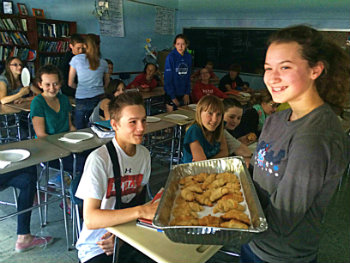
These groups, as I mentioned, are heterogeneous, behavior-based, and respectful of student’s pre-existing relationships and shared interests. I do not give students details about what I am doing or how I’m grouping them in this phase because I don’t want to tell them how I am grouping them in other phases when academic ability comes into play.
If students ask, I tell them that they will be moved around all the time, so they’ll eventually work with everyone, which is true.
What Resource Groups look like in practice
When I am introducing new material or beginning a unit, we will begin in these Resource Groups. I need the highest level of compliance in terms of behavior, and from my observations this approach works best.
In the early stages of a unit, I have many “turn and talk” moments, as well as brainstorming sessions. Additionally, this is often the stage when students are taking notes or making learning tools for the unit, both activities that benefit from a level of comfort with each other.
Essentially, during the most crucial early stages, students are in a no-risk environment. Carol Tomlinson, the guru of Differentiation “with a Capital D,” explains the three basic ways researchers have learned that students can differ in how they learn: readiness, interest, and learning profile.
Resource Groups address the learning profile of students – factors that can include gender, preferred method of learning, comfort level, and many intangibles that we can only learn from actually knowing the student herself.
Using the Fishbowl strategy with resource groups
One of the most engaging activities I use in my class is the Fishbowl discussion. Here’s how the student handout begins for a fishbowl designed as a pre-reading activity for our unit on The Giver.
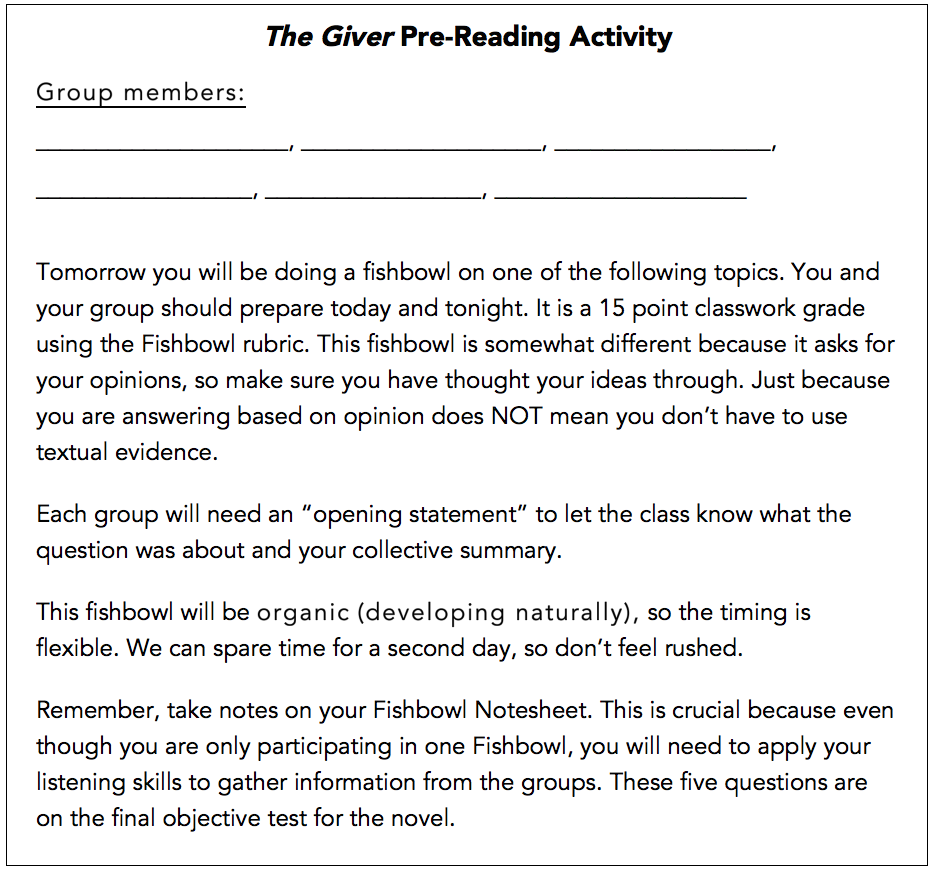
The room is arranged in a horseshoe or circle – whatever works best for your space. Inside, set up a table with five or six spots for students. The students in the middle are the “fish,” and the observers on the outside are looking at and listening to the fish, who are having a discussion.
To prepare for this discussion, which will be used to assess student’s understanding of both the questions and their ability to converse, students begin in their Resource Groups.
The first step is to give the Resource Groups all of the questions that could be discussed later in the Fishbowl. I overtly explain what is being asked in each question, give tips, and review what I’ll be assessing when they do their Fishbowl a few days later.
Click to download the complete rubric
I ask the Resource Groups to identify what they think to be the most difficult questions and highlight keywords. The next step will be to separate them into ability groups.
Ability grouping is part of my differentiation strategy
The detrimental impact of misused ability groups has been widely reported, and I think it led to an over-correction of never grouping students by ability, particularly after elementary school. Despite the obvious slots in middle and high schools based on ability – advanced and AP classes for example – teachers don’t always feel comfortable grouping by ability within their classrooms.
The key to ability grouping is that it is not permanent, not announced, and each group is given a valuable and challenging task, suitable for the students at the particular table.
The heterogeneous make-up used for the introductory and direct instruction phases of my units does not make sense during the second phase of learning. If used correctly, ability groups allow students an opportunity to rehearse what they are learning. This is the best time to give formative assessments, create interventions, and provide support.
Download more of my thoughts about ability grouping and more details about how I manage this in my classroom.
When we teach children – not content – amazing things happen!
If we focus first on teaching children, rather than teaching content, really amazing growth can happen.
Is my classroom always a mecca of differentiation and smiling success? Absolutely not. Some days, it seems like all this grouping and regrouping is more organizationally challenging than it is worth.
However, when I think about my own children, I am certain that I want their education to be responsive to their needs, and if it is a headache sometimes, so be it.
Is my room always arranged in tables and working together like Santa’s little elves, enjoying all this differentiation? No. Sometimes we are in vertical rows (assessment days), sometimes we are in horizontal rows (student presentations), and sometimes we are scattered around the room in a way that always looks so chaotic that I want to hang a sign saying: “Pardon the mess! 21st century learners doing their thing here!”
____________
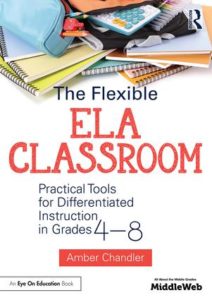
Amber blogs regularly for MiddleWeb’s The Flexible Classroom blog. She is an adjunct professor at Canisius College where she teaches “Differentiating Instruction” and also blogs regularly for ShareMyLesson and Getting Smart, contributes to AMLE Magazine, and provides NBCT candidate support for the National Board for Professional Teaching Standards.
Follow Amber on Twitter @MsAmberChandler and join her website http://doyoudifferentiate.com to access practical tips and resources. Read her many other MiddleWeb articles here.


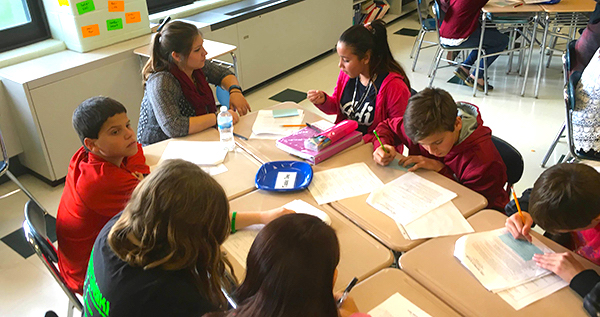
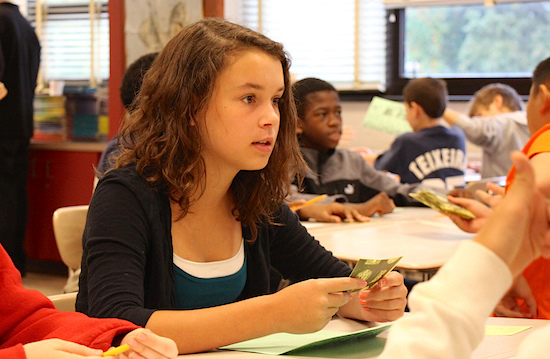
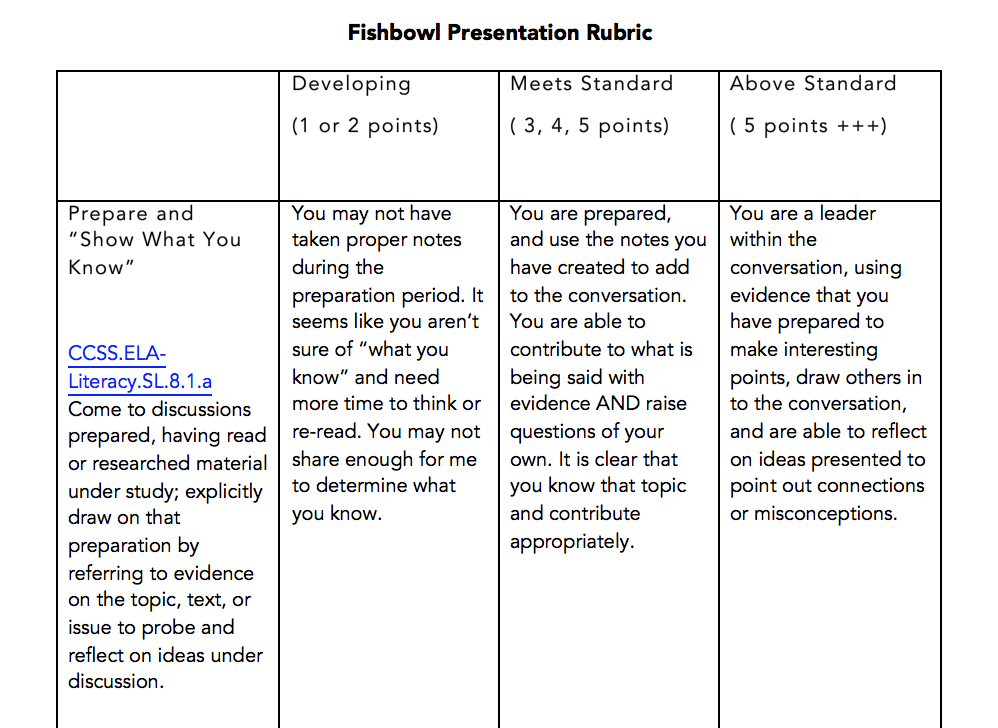
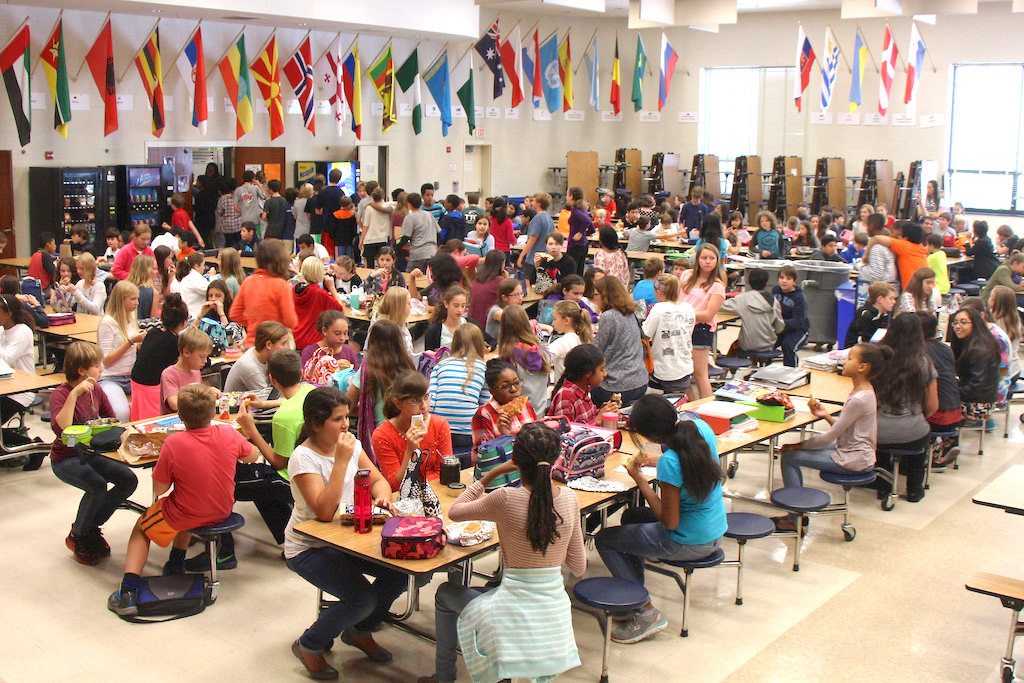


































Very nicely presented! Thank you for the practical application of grouping!
Thank you! Groups were one of the most difficult management issues I had to learn when I moved from high school to middle school. It really is an incredible tool. Chapter 2 of The Flexible ELA Classroom talks about it, but you can also find additional resources on my website doyoudifferentiate.com. There’s a Lit Circle assignment that explains how to move from the group dynamic to the individual assessment. Thanks for reading!
Thank you .. helpful insights …
Good stuff – I especially appreciate your thoughtful, experience-based qualification of ability grouping. Thanks!